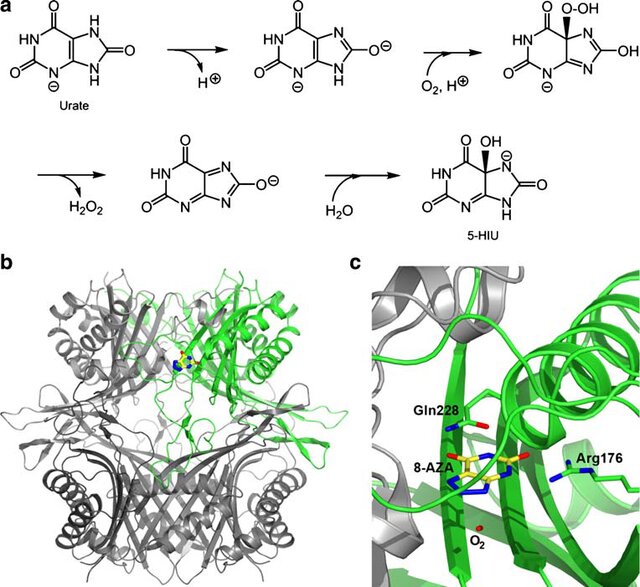What is UOX Protein
Urate oxidase, commonly known as UOX, is a crucial enzyme involved in the metabolic breakdown of uric acid. Its official full name is "urate oxidase," and it is also referred to as "uricase." UOX belongs to the protein family of oxidoreductases, specifically within the subclass of oxidases. This enzyme is primarily found in the liver of various organisms, including humans. It plays a pivotal role in the catabolism of uric acid, a waste product generated during the metabolism of purines, which are essential components of DNA and RNA.
UOX Protein Structural Characteristics and Classification
UOX proteins are typically homotetramers, composed of four subunits, each consisting of approximately 300 amino acids. These subunits work together to catalyze the conversion of uric acid to allantoin, a much more soluble compound that can be easily excreted by the body. This reaction involves the incorporation of molecular oxygen and the release of carbon dioxide and hydrogen peroxide. UOX's enzymatic activity is highly dependent on the presence of its cofactor, flavin adenine dinucleotide (FAD).

Figure 1. Urate oxidase (UOX). (Fetzner S, et al., 2010)
Recent Research Advances about UOX Protein
Recent research in the field of UOX protein has unveiled fascinating insights into its structure and function. The advancement of structural biology techniques, such as X-ray crystallography and cryo-electron microscopy, has allowed scientists to visualize the three-dimensional structure of UOX at an atomic level. These breakthroughs have deepened our understanding of how UOX binds to its substrate uric acid and how it forms a complex with FAD to initiate the uric acid degradation process.
Moreover, studies on the regulation of UOX expression have shed light on how the enzyme's activity can be influenced by various factors, including diet, hormones, and genetic variations. This knowledge is critical for comprehending the factors that can lead to conditions related to uric acid metabolism, such as gout and hyperuricemia.
UOX Biological Functions and Molecular Mechanisms
The primary function of UOX is to catalyze the conversion of uric acid into allantoin. Uric acid is a waste product resulting from the breakdown of purines, which are essential nucleic acid components. High levels of uric acid in the body can lead to the development of conditions like gout, kidney stones, and hyperuricemia. UOX plays a vital role in maintaining the balance of uric acid in the body by facilitating its breakdown and excretion.
The molecular mechanisms behind UOX's function involve a series of oxidation-reduction reactions. UOX binds to uric acid and utilizes molecular oxygen to initiate the conversion process. During this process, FAD serves as a cofactor, aiding in the transfer of electrons and facilitating the oxidation of uric acid. As a result, uric acid is transformed into allantoin, which is much more soluble and can be readily excreted by the kidneys. This enzymatic process prevents the accumulation of uric acid in the body, reducing the risk of related diseases.
UOX Related Signal Pathway
While UOX itself does not participate in signal pathways, the regulation of its expression and activity is influenced by various signaling mechanisms. Hormones like insulin and glucagon can modulate the expression of UOX in the liver, helping to maintain uric acid homeostasis. Dietary factors, such as the consumption of purine-rich foods, can also impact uric acid levels and UOX activity, although this is not a direct signaling pathway.
UOX Related Diseases
Dysfunction or deficiency of UOX can lead to several diseases and health issues. One of the most well-known is gout, a painful condition characterized by the crystallization of uric acid in joints. Additionally, individuals with a genetic deficiency of UOX may develop a condition called hyperuricemia, which is characterized by elevated uric acid levels in the blood. Hyperuricemia is a risk factor for gout, as well as kidney stones and even cardiovascular diseases.
UOX's Applications in Biomedical
UOX has several promising applications in the field of biomedicine:
- Diagnostic Development: UOX has been used in diagnostic assays to measure uric acid levels in the blood and urine. Elevated uric acid levels can be indicative of gout or other related disorders. By developing sensitive diagnostic tests based on UOX, healthcare professionals can accurately diagnose and monitor these conditions.
- Vaccine Development: Research is ongoing to develop vaccines for individuals with UOX deficiencies. These vaccines aim to stimulate the production of antibodies against uricase, helping to reduce uric acid levels in the body. By doing so, they may offer a potential therapeutic solution for individuals with hyperuricemia and gout.
- Therapeutics: UOX-based therapeutics are also being explored for the treatment of gout and hyperuricemia. These treatments aim to supplement or replace the deficient UOX enzyme in individuals with genetic deficiencies. By providing exogenous UOX, it may be possible to reduce uric acid levels and alleviate the symptoms associated with these conditions.
Recommended Products
| Cat.# | Product name | Species | Source (Host) | Tag |
|---|---|---|---|---|
| UOX-84H | Recombinant Urate Oxidase (Pseudogene) | Human | E.coli | N/A |
| UOX-01H | Recombinant Human UOX Protein | Human | E.coli | |
| UOX-80H | Active Recombinant Urate Oxidase | Human | E.coli | N/A |
| UOX-9925M | Recombinant Mouse UOX Protein, His (Fc)-Avi-tagged | Mouse | HEK293 | His (Fc)-Avi |
| UOX-17859M | Recombinant Mouse UOX Protein | Mouse | Mammalian Cell | His |
Reference
- Fetzner S, Steiner R A. Cofactor-independent oxidases and oxygenases. Applied Microbiology and Biotechnology. 2010, 86: 791-804.

